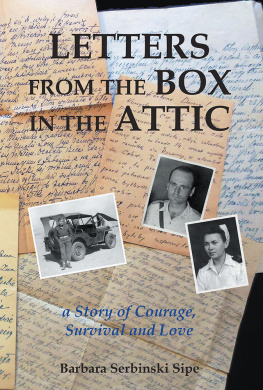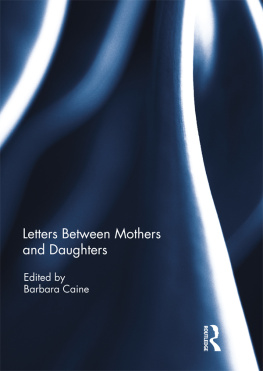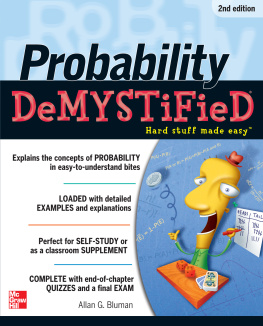I HAVE MY MOTHERS EYES

I HAVE MY MOTHERS EYES
A HOLOCAUST MEMOIR ACROSS GENERATIONS
Barbara Ruth Bluman
RONSDALE PRESS &
VANCOUVER HOLOCAUST EDUCATION SOCIETY
I HAVE MY MOTHERS EYES
Copyright 2009 Barbara Ruth Bluman
All rights reserved. No part of this publication may be reproduced, stored in a retrieval system, or transmitted, in any form or by any means, without prior written permission of the publisher, or, in Canada, in the case of photocopying or other reprographic copying, a licence from Access Copyright (the Canadian Copyright Licensing Agency).
RONSDALE PRESS
3350 West 21st Avenue, Vancouver, B.C., Canada V6S 1G7
www.ronsdalepress.com
Typesetting: Julie Cochrane, in Granjon 11.5 pt on 16
Cover Design: Shawna Romain & Kazuko Kusumoto
Paper: Ancient Forest Friendly Silva (FSC) 100% post-consumer waste, totally chlorine-free and acid-free
Ronsdale Press wishes to thank the following for their support of its publishing program: the Canada Council for the Arts, the Government of Canada through the Canada Book Fund, the British Columbia Arts Council, and the Province of British Columbia through the British Columbia Book Publishing Tax Credit Program.
Library and Archives Canada Cataloguing in Publication
Bluman, Barbara R
I have my mothers eyes: a holocaust memoir across generations / Barbara Ruth Bluman.
Co-published by the Vancouver Holocaust Education Centre.
ISBN: 978-1-55380-070-5 (print)
ISBN: 978-1-55380-289-1 (ebook) / ISBN: 978-1-55380-288-4 (pdf)
1. Bluman, Susan. 2. Holocaust, Jewish (19391945) Poland. 3. World War, 19391945 Jews Poland Biography. 4. Jews Poland Biography. 5. Bluman, Barbara R. Health. 6. Cancer Patients Canada Biography. 7. Mothers and daughters Biography. i. Vancouver Holocaust Education Centre ii. Title.
DS134.72.B58 B58 2009 940.5318092 C2009-900660-X
At Ronsdale Press we are committed to protecting the environment. To this end we are working with Markets Initiative (www.oldgrowthfree.com) and printers to phase out our use of paper produced from ancient forests. This book is one step towards that goal.
Printed in Canada by Marquis Printing, Quebec
Foreword
MY MOTHER, BARBARA RUTH BLUMAN , began the task of recounting her mothers escape during the Holocaust from Nazi-occupied Poland. This was no small assignment and made all the more challenging by her cancer diagnosis. When she died in 2001, the narrative was not yet complete; she asked me to finish it for her. As the initial pain of my mothers death began to settle, I undertook the process of completing her legacy.
The inspiration to publish this book began with the realization that my grandmother and mothers stories needed to be shared beyond our family circle. The Wosk Publishing Program of the Vancouver Holocaust Education Centre (VHEC) provided the opportunity to do so. I am grateful to the VHEC for seeing the value in this book and for their ongoing commitment to Holocaust education and understanding.
To complete my mothers work, I relied on the assistance of many. My cousin Adam Lewis Schroeder bravely tackled the first editing phase of the manuscript. In the midst of his own busy writing career and raising a family, Adam took the time to reorganize the memoir and even managed to interview my grandmother not long before she died in order to obtain a few last details.
I want to acknowledge the whole publishing team at Ronsdale Press for all the work they have done to bring this book to fruition. In particular, I want to thank Colin Thomas, who edited my grandmothers story and invested countless hours in helping me reshape the existing material in my mothers story. Through interviews with various family members and friends we were able to piece together the hidden layers of my mothers experience and bring them to life. Thank you.
I would also like to acknowledge all of the people who shared their memories in order to bring our familys history to life in the most truthful way possible. Specifically, I would like to thank my Uncle George for being such an important resource, and my father Drew Schroeder, my uncle Bob Bluman and my friend Jim Henning for being willing to be interviewed.
I am grateful to my brothers, Michael and Sam, and my husband Marc, who supported me throughout this process and who were always willing to ease my insecurities and celebrate my accomplishments.
One final and important acknowledgement: I thank my mother Barbara Ruth Bluman, who trusted me far more than I have ever trusted myself to complete this book for her. Without her faith in me, I would never have had the courage to go deeper into our family story and truly learn what it means to have my mothers eyes.
Danielle Bluman Low (Schroeder)
January 2009


Map showing the escape route from Poland to Japan
Pieces of a Tea Set
ALL CHILDREN LOVE to hear about when they were babies. Your eyes were so blue, her parents would tell her, and so intelligent.
Six-year-old Zosias colouring came from her father. He, too, had dark, curly hair as well as the full beard of orthodox Jewish men and his blue eyes were so clear that they were almost hypnotic.
Soon she would be too old for it, but Zosia still slept with her parents, Symcha and Estera Hoffenberg. Every night Symcha plied her with kisses, and then she nested in the contours of his body. When he took her shopping, she could cajole him into buying anything she wanted. They played cards together. And they walked. Even now, in the winter, the pair bundled up and walked through parks, along bustling streets, and over to the cinema to watch American movies made by Charlie Chaplin. In one, the poor little tramp was so hungry that he had to eat the nails from his shoes. Zosia loved the movies, but Symcha would always fall asleep, snoring and embarrassing his daughter. It was worth every penny, hed say as they made their way home. I had my best sleep ever!
The whole family attended services in the synagogue. Men and women sat apart, but sometimes Zosia was able to sneak over to the mens side and sit by her father. Symcha always seemed happy to see her, but he was too engrossed in prayers to give her much attention. His body swayed to the rhythm of the words as he chanted and prayed, and Zosia watched tears drip from his eyes.
Zosias relationship with her mother was less easy. When Zosia was born on September 1, 1920, in Warsaw, Poland, Estera was thirty-nine years old and she already had three children: thirteen-year-old Ruta, ten-year-old Regina and nine-year-old Heniek, the only boy. Estera had been enjoying increased freedom as her children grew older, and she hadnt relished looking after a new baby.
Unlike her youngest daughters bold, bright-eyed looks, Esteras features were dark and delicate. She was proud of her good figure and disapproved of women whom she felt did not look after themselves. Estera wore her long, dark hair in a neat, fashionable bun, and not a morning passed that she didnt put on her corset. Her days were often filled with appointments at the hairdresser, manicurist and dressmaker.










